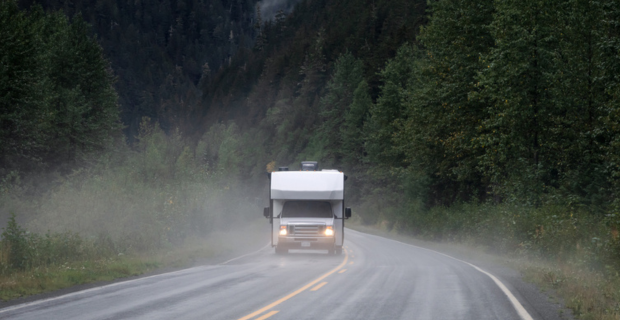Date Published: 2024/05/07
Read Time: mins
Tips for driving your RV in the rain

Rainy weather conditions can make roads slick and affect driving conditions. Driving in the rain can be especially challenging as you operate your RV. After protecting your home from rain, learn how to protect your RV on the road. Consider several top tips that help you drive your RV safely in rainy weather conditions.
Check the weather forecast
Before hitting the road, verify the forecasted weather conditions on the way to your destination. You may want to postpone your trip or schedule an extra day or two at the campground if heavy rainstorms are expected.
Choose an alternative route
Rather than driving through a rainstorm, select a route with sunny weather. Or choose a route that detours away from streams, rivers or floodplains.
Maintain your RV
Prepare your RV to navigate inclement weather with routine maintenance. Likewise, perform a pre-trip inspection before each excursion. You can check the tires for signs of wear or damage, and inflate them properly to help improve traction. Then, inspect and clean the windshield wipers and headlights to boost visibility. Fill your RV with fuel also in case you need to pull over and wait for a rainstorm to pass.
Proceed with caution
When driving in the rain, practise safe driving techniques. Slow down to prevent slipping and sliding. Turn on your windshield wipers and headlights to improve visibility. Maintain double the normal stopping distance between you and the vehicles in front of you. Be prepared with a plan in case you encounter fallen tree limbs and standing water. You might even pull off to the side of the road or wait at the nearest rest stop until the storm stops.
Handle your specific RV properly
Driveable and towable RVs handle differently on the road. Knowing how to operate your specific RV during rain prepares you to safely drive during inclement weather.
To handle your Motorhome, remember that it’s probably rear-wheel drive. That means the front wheels steer your RV and the back wheels propel your RV forward. This design requires careful steering and extra attention to your surroundings.
To handle your travel trailer, remember that the extra weight makes braking more difficult. To stay safe, reduce your speed and maintain extra following distance. Additionally, avoid driving through puddles. Although the vehicle you’re driving probably has four-wheel drive with extra traction, it could hydroplane or fishtail in wet conditions.
Prevent hydroplaning
Driving your RV in the rain puts you at risk of hydroplaning or aquaplaning. This condition could happen when your tires hit water and lose contact with the road. With reduced traction, you could become unable to brake, accelerate or steer your vehicle and lose control of your RV.
To prevent hydroplaning, turn off cruise control and slow down. If you do find your RV hydroplaning, try to remain calm. Gently pull your foot off the accelerator, but do not slam on the brakes. Hold your steering wheel in the direction your RV is moving to avoid skidding. When you regain control of your RV, gently brake and maintain a slow speed.
Avoid standing or moving water
If you do approach standing or moving water, stop. Even a few centimetres of standing water could damage your RV. Standing water could also conceal potholes, open drains, tree branches, or other dangers. And your RV could float away in as little as 30 centimetres of moving water.
However, if you can safely navigate your RV through standing water, proceed with caution. Use a low gear and maintain a steady pace. Try to remain in the middle of the road and away from the shoulder. If the water rises above your wheel rims, test the brakes after you leave the water to ensure they work properly.
Pack helpful supplies
Certain supplies could help keep your family comfortable and safe if you’re stranded during stormy weather. For example, consider packing extra non-perishable food, drinking water, fuel, first aid supplies, blankets, flares, reflectors, and activities. You can also customise this list based on your family’s needs and preferences.
Update your insurance
These tips can help you navigate rainy conditions. Likewise, review your RV insurance policy before your next adventure. Ensure you have adequate coverage for your rig and gear. You may also request a quote from Orbit Insurance Services for RV insurance. With adequate coverage, you gain peace of mind while driving your RV in the rain and other weather conditions.